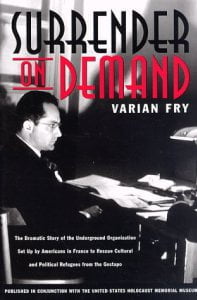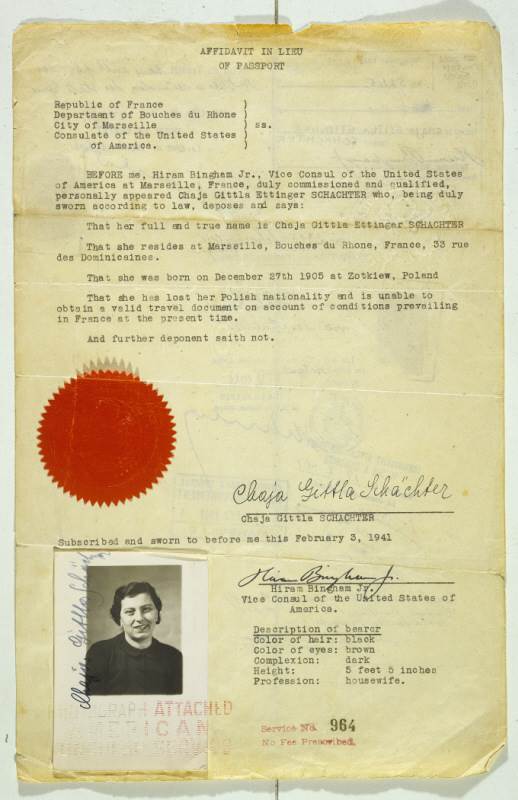Surrender On Demand – Varian Fry In Nazi Occupied France
 When I started to read his book “Surrender on Demand – Rescue of German Emigrants in Marseilles 1940/41 “ I was instantly caught by his work and stories. You get a vivid impression how Paris was at that time when it was occupied by the Nazis and how dangerous it was for refugees and enemies of the Third Reich. This article will give you some kind of book review and for any serious interested reader and collectors of documents from the “Righteous” you will get facts of Frey’s work from first hand.
When I started to read his book “Surrender on Demand – Rescue of German Emigrants in Marseilles 1940/41 “ I was instantly caught by his work and stories. You get a vivid impression how Paris was at that time when it was occupied by the Nazis and how dangerous it was for refugees and enemies of the Third Reich. This article will give you some kind of book review and for any serious interested reader and collectors of documents from the “Righteous” you will get facts of Frey’s work from first hand.
Varian Fry, was an extraordinary and courageous man who, under difficult circumstances, led the most successful American rescue during the occupation of the Third Reich in France. He saved over 2,000 artists, intellectuals, philosophers and scientists trapped in Nazi-controlled Vichy, France 1940-41.
He was a man of principle and believed in man’s humanity to man. In 1935, as a journalist visiting Berlin, he saw brutality on the streets. The vision forever changed the course of his life. In 1940, he jumped at the chance, given by the Emergency Rescue Committee, to head the rescue of refugees.
Recognition for his extraordinary work came belatedly, not even from his own country. Five months before his death, France awarded him the “Croix de Chevalier de la Legion d’Honneur. He was awarded The Eisenhower Liberation Medal posthumously, then in 1996, Yad Vashem, The Holocaust Martyrs and Heroes Remembrance Authority in Jerusalem honored Fry as the first (until 2007) American as “Righteous among the Nations”. Since then, streets and schools and institutions both in Germany and France have been named for him. The Town of Ridgewood, New Jersey, where he was raised, has a plaque bearing his name and the local high school gives scholarships honoring him.
Upon hearing about Article 19’s “surrender on demand” the Emergency Rescue Committee emerged from a joint initiative of Paul Hagen, Varian Fry, the German Jewish immigrant Ingrid Warburg, presidents of American universities including Alvin Johnson (The New School), Charles Seymour (Yale), and Alfred Barr, first director of The Museum of Modern Art. The ERC was funded by private donors, with Peggy Guggenheim and heiress Mary Jane Gold—the latter of whom worked with Fry in Marseille—among its major supporters. Fry was hurriedly sent with $3,000 taped to his leg and a list of 200 of Europe’s most famous artists and intellectuals who were on the Nazi’s wanted list. These individuals were persecuted because of their Jewish descent, public opposition to the National Socialists, or political activities.
Among the Nazi opponents who were rescued were Marc Chagall, Hannah Arendt, Max Ernst, Leonora Carrington, Nobel Laureate Otto Meyerhof and Spain’s leading Catholic philosopher Alfredo Mendizabel. When Eleanor Roosevelt learned that Lion Feuchtwanger was already incarcerated, she gave the Committee her support, enlisting the aid of the State Department to send someone to Vichy France. Rescuing the intellectual and artistic elite led to the strengthening of American intellectual, artistic life and culture. Their influence is still felt today.
Marseilles, France… August 1940 – On June 22, 1940, France surrendered to Germany and the two countries signed an armistice. France was divided into a Northern Zone, which was occupied by the Germans, and a Southern Zone, which was controlled by a French government, based in the town of Vichy, that was eager to assist the Nazis. Thousands of refugees living in the Southern Zone, both Jews and anti-Nazi non-Jews, were suddenly in danger of being turned over to the Gestapo (German secret state police) and sent to Germany. Troubled by this situation, a group of American citizens formed a relief organization to help the refugees. They called it the Emergency Rescue Committee (ERC). Click the link for more details.

Some facts from the book…
- Fry’s assignment was initially limited to three month but ended up with thirteen month
- The American Trade Union Federation played a significant role to convince the State Department to issue emergency visas
- American Vice Consul in France, Hirham “Harry” Bingham was a supporter of Fry
- Bingham was in fact the rescuer of Lion Feuchtwanger
- Fry organized mainly genuine and fake documents such as transit visas to Portugal, Spain and even Chinese and Siam visas
- The Chinese visas were issued in Chinese and had in fact the wording “The bearer is not allow, under no circumstances, to enter China”
- Above fact did not matter as long the Portuguese accepted the visas (as they couldn’t read Chinese)
- Same circumstances with the Siam visas…
- Most difficult for Fry was to organize visas for stateless persons, which citizenship was revoked by the Nazis
- The French “Titre de Voyage” (some kind of refugee document) was not accepted by Spain and refugees were sent back
- Fry organized via the ERC emergency visas and the American consulate issued then usually also an “affidavit in lieu of passport” (see below)
- The Czechoslovakian Consul in France was also a supporter of Fry and issued fake passports. According Fry’s statement these documents had a rose cover color so it must be the “Temporary passport type” of the Czech passport. These types are very rare to find for collectors
- Also in use were Polish passports from the Polish Consul in Marseilles and Lithuanian passports issued by the Italian Consul Ax-en-Provence
- Panamanian visas issued by the Honorary Consul of Panama in Marseille
- Czech Temporary passport with Siam visa
But the question remains what documents you could possibly find as collector from Fry? Maybe only internal or official ERC documents!

FAQ Passport History
Passport collection, passport renewal, old passports for sale, vintage passport, emergency passport renewal, same day passport, passport application, pasaporte passeport паспорт 护照 パスポート جواز سفر पासपोर्ट
1. What are the earliest known examples of passports, and how have they evolved?
The word "passport" came up only in the mid 15th Century. Before that, such documents were safe conducts, recommendations or protection letters. On a practical aspect, the earliest passport I have seen was from the mid 16th Century. Read more...
2. Are there any notable historical figures or personalities whose passports are highly sought after by collectors?
Every collector is doing well to define his collection focus, and yes, there are collectors looking for Celebrity passports and travel documents of historical figures like Winston Churchill, Brothers Grimm, Johann Wolfgang von Goethe. Read more...
3. How did passport designs and security features change throughout different periods in history, and what impact did these changes have on forgery prevention?
"Passports" before the 18th Century had a pure functional character. Security features were, in the best case, a watermark and a wax seal. Forgery, back then, was not an issue like it is nowadays. Only from the 1980s on, security features became a thing. A state-of-the-art passport nowadays has dozens of security features - visible and invisible. Some are known only by the security document printer itself. Read more...
4. What are some of the rarest and most valuable historical passports that have ever been sold or auctioned?
Lou Gehrig, Victor Tsoi, Marilyn Monroe, James Joyce, and Albert Einstein when it comes to the most expensive ones. Read more...
5. How do diplomatic passports differ from regular passports, and what makes them significant to collectors?
Such documents were often held by officials in high ranks, like ambassadors, consuls or special envoys. Furthermore, these travel documents are often frequently traveled. Hence, they hold a tapestry of stamps or visas. Partly from unusual places.
6. Can you provide insights into the stories behind specific historical passports that offer unique insights into past travel and migration trends?
A passport tells the story of its bearer and these stories can be everything - surprising, sad, vivid. Isabella Bird and her travels (1831-1904) or Mary Kingsley, a fearless Lady explorer.
7. What role did passports play during significant historical events, such as wartime travel restrictions or international treaties?
During war, a passport could have been a matter of life or death. Especially, when we are looking into WWII and the Holocaust. And yes, during that time, passports and similar documents were often forged to escape and save lives. Example...
8. How has the emergence of digital passports and biometric identification impacted the world of passport collecting?
Current modern passports having now often a sparkling, flashy design. This has mainly two reasons. 1. Improved security and 2. Displaying a countries' heritage, icons, and important figures or achievements. I can fully understand that those modern documents are wanted, especially by younger collectors.
9. Are there any specialized collections of passports, such as those from a specific country, era, or distinguished individuals?
Yes, the University of Western Sidney Library has e.g. a passport collection of the former prime minister Hon Edward Gough Whitlam and his wife Margaret. They are all diplomatic passports and I had the pleasure to apprise them. I hold e.g. a collection of almost all types of the German Empire passports (only 2 types are still missing). Also, my East German passport collection is quite extensive with pretty rare passport types.
10. Where can passport collectors find reliable resources and reputable sellers to expand their collection and learn more about passport history?
A good start is eBay, Delcampe, flea markets, garage or estate sales. The more significant travel documents you probably find at the classic auction houses. Sometimes I also offer documents from my archive/collection. See offers... As you are already here, you surely found a great source on the topic 😉
Other great sources are: Scottish Passports, The Nansen passport, The secret lives of diplomatic couriers
11. Is vintage passport collecting legal? What are the regulations and considerations collectors should know when acquiring historical passports?
First, it's important to stress that each country has its own laws when it comes to passports. Collecting old vintage passports for historical or educational reasons is safe and legal, or at least tolerated. More details on the legal aspects are here...
Does this article spark your curiosity about passport collecting and the history of passports? With this valuable information, you have a good basis to start your own passport collection.
Question? Contact me...

